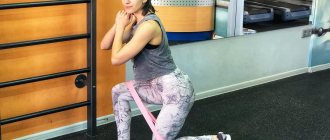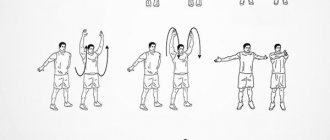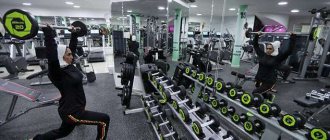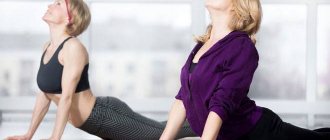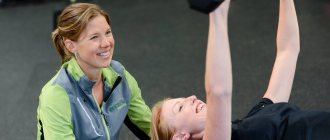For the workout to be fruitful, you need to stretch your muscles. It won't take much time, and you will feel the results from the very beginning of the workout.
If you properly warm up before starting your workout and stretch after it, your training will be more effective and you will be less likely to get injured.
The 10 minutes you save by ignoring these important training components may come at a very high cost, such as missing the desired results or a nasty injury.
Warm-up is the introductory part of the workout, the purpose of which is to prepare the body for more intense loads. It performs this function perfectly, significantly increasing the effect of the main activity.
At the same time, warm-up exercises are effective on their own. Their daily implementation normalizes blood circulation, strengthens joints, increases muscle tone, and promotes weight loss.
Purpose of warm-up
Why do you need to warm up? Why not get straight to the main goal? – many are perplexed. The fact is that warming up “triggers” changes in the body that optimally prepare it for the work ahead.
If you do not warm up, these changes will begin to occur during the main load, which will reduce efficiency. Also, without warming up, there is a high risk of injury and attacks of chronic diseases. Let's give an example of the simplest possible warm-up.
What are these changes?
- Warming up improves neuromuscular interaction - reactions accelerate, coordination of movements improves.
- Metabolism becomes more intense. Body temperature rises, sweating accelerates, facilitating the process of removing waste products from the body.
- The work of the circulatory and respiratory organs, which provide the muscles with oxygen and substances that provide the necessary energy for muscle contraction, accelerates.
- Muscles and ligaments become more elastic. This reduces the risk of injury.
- The endocrine glands begin to work differently. Because of this, restructuring occurs in the body faster and easier.
- The volume of blood in the bloodstream increases. This makes it easier to transfer oxygen and other substances important for the normal functioning of the body.
Warm-up rules
It is important to always remember simple rules:
- Since the work of the digestive organs is inhibited during warm-up, it is not recommended to eat one and a half to two hours before and after training. If it is impossible to maintain the required interval, have a light snack.
- You can start the main exercises 3-5 minutes after warming up, but you can do this later.
- The warm-up itself should last at least 10 minutes and more than 50 minutes, unless, of course, it is the main activity.
- The “correct” warm-up consists of two parts – general and special. During the general part, the work of physiological systems responsible for muscle function - nervous, respiratory, motor, cardiovascular, thermoregulation, etc. - becomes more intense. During the special part, those parts of the motor system that will be involved in the upcoming activity are prepared for work.
If you have ever been diagnosed with high blood pressure, heart disease, other organs, or the musculoskeletal system, you should start exercising only after consulting a doctor.
Warm up before strength training
This is not only a precautionary measure, it also has positive long-term effects. A good warm-up routine will prevent injury and increase weight gain by warming up your strength and concentration.
An important element is monitoring your heart rate. Try to work in the first pulse zone and select warm-up exercises before the main workout in such a way that they do not overload your body and it does not become acidic ahead of time. Monitor your heart rate using the heart rate monitor on your arm. In this case, it is necessary to select light physical complexes, and the heart rate should be from 50 to 65% of the maximum.
Performing a warm-up routine will help develop the entire body as a whole and the functioning of the heart. The optimal warm-up duration is from 10 to 20 minutes. For strength training, when performing the FIRST exercise on a specific muscle group, it can consist of three stages:
First stage
The first thing you need to concentrate on during the warm-up is to pump up your muscles a little. The best way to do this is to perform 1-2 sets of 8-12 repetitions with a very light weight.
Feelings: at first you will be a little uncomfortable, there is a feeling of weakness. After the second set you begin to feel stronger.
Second phase
The next step is to prepare the muscles to lift heavy weights to failure. The next two sets should be performed with a load very close to what you will use in the first working set. Do only 1-2 repetitions, you will not tire your muscles and will not provoke microtrauma.
Feelings: It’s already hard for you, but it’s just a mental block that you will overcome. This is why warming up with weights is useful. The last approach is more difficult to perform, but you will begin to feel more confident.
Third stage
It is a mistake to believe that the next step in the warm-up is the transition to working approaches. After a hard warm-up, you should definitely rest for 2-3 minutes. This will reduce fatigue, and at the same time blood flow will remain at the same level.
Feelings: after the previous warm-up sets, you will perform this set confidently.
Next steps
You don't repeat the pre-workout warm-up exercises, but simply continue doing strength sets (most lifters do 2-4 sets of each exercise).
After warming up for one muscle group, you do not need to repeat the warm-up for that group throughout the entire gym session. For example, if you plan to deadlift, a light set of 8 reps with 40-60% of the lifting weight is sufficient as a warm-up.
But remember that it is better to warm up each muscle group. For example, if it's leg day, you should do squats first. Get into position and do a few warm-up sets. You will increase flexibility specifically for this exercise and prepare your body directly for squats. But you shouldn’t straighten your legs as a warm-up.
Sometimes the weight will seem unnaturally light or excessively heavy. If this happens, do another warm-up set with a load, and the heavy feeling should go away. The best way to prepare for a work set is to approach it with a feeling of confidence and strength, without fatigue.
This is exactly what a warm-up will help achieve.
Exercises for general warm-up
Of course, there are a lot of warm-up exercises. And it’s unlikely to be possible to list everything. Therefore, I will list only the most popular ones. Most of them are familiar to you from physical education lessons.
Cervical spine
Head tilts
This exercise is performed standing. The back should be straight, shoulders down, neck muscles relaxed. Lower your head, trying to reach your chin to your chest. At the same time, we move our shoulders forward and round our back. Then we tilt our heads back. And we spread our shoulders, sticking our chest forward. Afterwards, we tilt to one side, trying to reach our ear with our shoulder. We do 10-15 such tilts in each direction.
Circular head rotations
The position for the exercise is the same. Lower your shoulders and relax your neck. We begin to rotate our head clockwise and counterclockwise. We do 10-15 repetitions in each direction. We try to perform circular rotations at full amplitude.
Shoulder muscles
Shoulder Raise
From the starting position described above, we begin to raise our shoulders up. The main task is to try to raise them as close to the ears as possible. This exercise is similar to SHRUGS, but is performed without weight. The number of repetitions is at least 20.
Shoulder rotations
Now we complicate the exercise a little and begin to rotate our shoulders clockwise and counterclockwise. Don’t forget to bend and move your deltoids forward and back. This will give us the opportunity to work at maximum amplitude. Also, we do at least 20 repetitions.
Circular rotations with hands
Again, we make the exercise a little more difficult by straightening your arms completely. Now we are working as much as possible on warming up the shoulder joints. You can rotate your hands either clockwise or counterclockwise.
Arm muscles
Forearm rotations
Spread your arms out to the sides and bend them. From this position, we begin to rotate our forearms in different directions. Just don't just wave your arms. Movements should be at an average pace and completely under your control. We perform 20-30 repetitions in each direction.
Rotations in the hands
There are two options here:
- Raise your arms to the sides and rotate your hands clockwise and counterclockwise.
- Clasp your palms, placing them on top of each other. And we rotate them in different directions.
We also do 20-30 repetitions.
Warm up the pectoral muscles
Raising arms to the side with a turn
This is an excellent exercise that warms up not only the pectoral muscles, but also the oblique abdominal muscles. Stand up straight. Feet shoulder width apart. Bend your elbows and place them in front of you so that the fingertips of your two hands touch. We take in air, filling the chest with it. We make a turn in any direction and spread our arms to the sides. We do 10-15 times in each direction. In this exercise, you can make slightly jerky movements at the time of extension. This will give more effect.
Warm up your back and core muscles
Four-way tilts
This exercise will warm up your back and abdominal muscles. Stand up straight. Place your feet slightly narrower than shoulder width. We place our hands on our sides. From this position we lean forward. Then we bend back as far as possible. Next, we tilt to the right and then to the left. The number of repetitions is at least 10 times.
Circular movements of the pelvis
Let's stand up straight. We put our hands on the belt. Feet shoulder width apart. We begin to rotate the pelvis clockwise. Having made a full circle, we change the direction of movement. We try to work at full amplitude. That is, we draw the largest possible circle with our pelvis. Do it at least 20 times in each direction.
Leg warm-up
Hip rotation
We stand straight. We lean with one hand on any ledge for greater stability. Bend the opposite leg and lift it up. From this position, we begin to rotate in any direction. Then we change legs. We do 10-15 times on each leg.
Bent over knee rotation
We place our feet shoulder-width apart. We lean forward and place our palms on our knees. From this position, using your hands, we begin to rotate your knees in both directions. We do this 10-15 times in each direction.
Squats without weight
Feet shoulder width apart. We put our hands in front of us. During a squat, we try to move the pelvis back as much as possible. We do it at least 20 times.
Calf raise
We stand straight. Feet hip-width apart. Hands on waist. From this position, we rise up onto our toes as much as possible, contracting the calf muscles. We return to the starting position slowly and under control. We do it at least 20 times.
These exercises are simple, but very effective. If you don't know where to start warming up, you can use the above example.
To illustrate how the warm-up is performed, I suggest watching the video:
Full body workout
If the athlete slightly warms up the muscles, there is no harm. However, if you stretch for too long, more than 15-20 minutes, the muscles will have difficulty contracting. And this will negatively affect your results.
It's better to do warm-up exercises before training, and leave stretching for dessert.
Only in some cases is it useful to stretch before training. For example, if the muscles are too stiff, using a simple complex you can relax them and bring them into working condition. But because there isn't as much blood flow to the muscles before a workout as there is afterward, stretching can lead to pain and injury.
We recommend the following basic warm-up complex. They are intuitive and reminiscent of the warm-up series that we all did at school in physical education lessons. It will take you no more than 5 minutes to complete 10-12 exercises. Want to get a better workout? Complete 2 laps.
Rules for doing warm-up at home
In order for stretching or warming up, which can be done at home before the main workout, to bring maximum benefits to the body, you need to allocate only 10-12 minutes for it and follow the following rules:
- You should start classes with exercises for the neck and then you need to warm up the muscles located below (arms, shoulder girdle, chest, back, legs);
- You should warm up at a dynamic pace, facilitating the transition to more intense loads;
- to avoid injury, you need to move with a gradual increase in amplitude;
- when warming up, it is better to avoid prolonged static positions;
- the nature of the movements should be easy and smooth, they should not be accompanied by pain or discomfort;
- if it’s cool at home, then to warm up faster, you can increase the training time or wear warmer clothes;
- If the upcoming training is designed for a specific part of the body, then it needs to be given special attention.
All the features and nuances of effective warm-up and stretching before training can be found here:
Full body warm-up complex
Stretch the neck muscles to the sides
- 10-15 seconds
- Body Part: Neck Equipment: No
Hand rotations
- 10-15 seconds
- Body Part: Shoulders Equipment: No
Dynamic stretching of the back muscles
- 10-15 seconds
- Body Part: Lat Equipment: No
Dynamic pectoral stretch
- 10-15 seconds
- Body part: Chest Equipment: Body weight
Delt stretching
- 10-15 seconds with each hand
- Body part: Shoulders Equipment: Body weight
Jumping lunges
- 10-15 reps
- Body Part: Hamstring Equipment: No
Standing bent leg rotations
- 10-15 seconds with each leg
- Body part: Adductor muscle Equipment: Body weight
Circular movements of the knees
- 10-15 seconds clockwise and counterclockwise
- Body part: Calves Equipment: Body weight
Swing your leg forward and backward
- 10-15 seconds with each leg
- Body part: Hamstrings Equipment: Body weight
Ankle rotation
- 10-15 seconds with each leg
- Body part: Calves Equipment: Body weight
Add to Calendar * Add to My Workouts * Print Workout
* — The service is in beta testing
Basic warm-up movements can be effectively combined with cardio and light strength training. Let's look at what other exercises you have in your arsenal.
Aerobic warming up
Aerobic warm-up (cardio exercise) - includes exercises of fast walking in place with knees raised, walking with arms and legs stretched out to the sides, running in place. Each exercise is performed for 30-40 seconds.
Exercises for joints are rotational movements
All exercises are done 8-10 times, on the right and left sides, clockwise and counterclockwise.
- Crescent head rotation (without throwing your head back)
- shoulder rotation
- elbow rotation
- hand rotation
- wrist rotation
- pelvic rotation
- leg rotation
- knee rotation
- rotation of feet
Muscle stretching
This is dynamic muscle stretching, swings, bends, squats, turns, lunges. Each exercise takes 15-20 seconds.
- raising your arms in front of you and to the sides
- shoulder stretch
- triceps stretch - hands behind head
- tilts in one direction and the other
- bending body turns - reaching with your hand to the opposite leg
- squats
- body rotations in a squat
- rolls - side lunges to warm up the legs
- lunges
- hamstring stretch - reaching towards the toes of your forward leg
- quadriceps stretch - press the leg bent at the knee to the buttock
The final cardio warm-up is needed to warm up even more and increase body temperature. The intensity of movements is increased compared to the beginning of the warm-up. Each exercise is performed for 40-50 seconds.
- running in place
- jumping rope
- jumping with arms and legs raised
Restoring breathing is necessary to calm down somewhat before starting the workout itself. Performed with a squat or bending the body forward for 1 minute or a little less.
A special warm-up is usually performed before training with heavy weights. In this case, the same exercises are performed as in the main training, but without weights or with light weight - no more than 30% of the maximum weight. The kneading approach is performed for 10-15 repetitions. A special warm-up cannot replace a general one and is performed after it.
Before running or cardio training, a general warm-up with light cardio exercise is also necessary, then working out the joints and warming up the muscles.
General recommendations for warming up before training:
- Warm-up occurs from top to bottom - from the neck to the feet.
- Warm-up exercises are performed at a dynamic pace, starting from a slower pace, increasing the amplitude.
- The warm-up should not be too long or too intense, otherwise you will have time to get tired before the main workout.
- If during the main training you plan to focus on any specific part of the body, you need to pay increased attention to it during the warm-up. For example, before training your legs, you need to more carefully develop your knee and hip joints.
Warm-up doesn't take much time or effort. But it promotes more effective training, protects you from injuries as much as possible, and prepares the body for the upcoming load. Some athletes say that warming up without training is better than training without warming up. And they are absolutely right!
Cardio warm-up at home and in the gym
Circular - 3 laps
Easy jumping in place
- 30 seconds
- Body part: Calves Equipment: Other
Jumping forward in a half squat
- 30 seconds
- Body part: Quadriceps Equipment: Body weight
High jump with uneven leg
- 5 reps on each leg
- Body part: Quadriceps Equipment: Body weight
Jumping rope
- 30 seconds
- Body part: Calves Equipment: Other
Add to Calendar * Add to My Workouts * Print Workout
* — The service is in beta testing
What else can be added to this circular series? The following two dynamic mini-series will make your training unforgettable. They are extremely simple to repeat and at the same time perfectly warm up all the necessary parts of the body for home workouts.
Dynamic hamstring stretch
The series consists of a half-squat, straightening the legs and pulling the torso up. On the exercise page you can watch the technique in detail in the video.
Dynamic hamstring stretch
Triple stretch
Lunge forward and squat down. Place your hand on the side of your leg in a lunge, with your other hand parallel to your working leg. Place your hands on either side of your front leg. Lift your toes and straighten your leg. Also, use video technology if necessary.
Triple stretch
What other simple exercises will help you quickly stretch your entire body at home?
Running in place with a high hip lift
In addition to everything listed above, we offer a “secret weapon” that will bring your body to full tone in 1 minute! Running in place is an excellent coordination and aerobic cardio endurance exercise. Since the movement involves almost all parts of the body, you will feel your heart rate increase to the desired value within 10 seconds.
Some girls have special equipment at home, for example, a fitball. If you were wondering how to do an effective warm-up at home using a regular exercise ball, now you have the answer.
Warm up with fitball
Often, when working on problem areas, one simple trick helps get things moving: you need to surprise your body. Do this unusual, incendiary workout on a fitball with us.
Yoga warm-up routine
Successful and time-tested exercises can be borrowed, for example, from yoga. We suggest you try the warm-up complex “Sun Salutation - Surya Namaskar”, which will warm up the whole body in 2 minutes.
If everything is clear with the warm-up, then there is a lot of controversy about stretching before training.
Stretching before or after exercise
The best time to stretch is immediately after a workout. You don't have to worry about the possibility of lower results. When you finish working out in the gym, your muscles are still tense. They pump with blood and oxygen, giving them a better range of motion.
Stretching after exercise is beneficial because it prevents some of the negative effects.
A muscle strain is caused by the pulling of antagonist muscles. After the negative or lengthening phase of the exercise, they are fully stretched. Thus, a good stretch for any muscle is the usual relaxation after exercise. For example, you’ve finished a set of pull-ups, just hang there.
But some exercises don't allow you to stretch. Want to succumb to the weight of a barbell in a squat position for 60 seconds? You'll be more concerned about maintaining your balance than the quality of your stretch. Below are some safe and easy stretches to tone your muscles.
Warm-up structure before training in the gym
First of all, do a little joint exercises. It does not take a lot of time. Perform rotational movements, turns in different directions and similar movements. We recommend starting from top to bottom and warming up in approximately this order:
- cervical spine;
- shoulder joints;
- thoracic spine;
- elbow joint and hands;
- lumbar spine;
- knees;
- ankle and calves.
Choose one or two movements that you are comfortable doing. Perform 20-30 repetitions of each. This will warm up your joints and ligaments and protect them from damage during heavier work. Stick to an average pace; there should be no sudden or jerky movements. Approximate time for performing the joint gymnastics complex: 3-5 minutes.
Stretching
As the next step, we recommend a small stretching routine. We need to statically stretch each muscle group. This mobilizes muscle tissue, stretches fascia, and stimulates blood and oxygen flow to cells. There is no need to stretch for a long time; it is enough to linger at the point of maximum tension for about 15 seconds.
Start doing it the same way – from top to bottom. Pay special attention to the pectoral muscles, latissimus dorsi, spinal extensors, hamstrings, and hip adductors. This way you will prepare your muscles for the power load, protect yourself from injury and you will better feel the contraction and stretching of the muscles in each repetition.
To stretch all the back muscles, a regular hang on the bar is suitable. The most comfortable way to stretch the pectoral muscles is by leaning one hand on the squat rack and leaning your whole body forward. To stretch your lower back and hamstrings, use hyperextensions and straight-legged forward bends. Approximate stretching time: 3 minutes.
Cardio
The next step is to do some light cardio. Your task is to prepare the cardiovascular system for stress. Do light aerobic exercise with a heart rate of up to 130 beats per minute. This is the average heart rate at which the processes of lipolysis (oxidation of adipose tissue) are launched. Walking on a treadmill, exercise bike, stepper or ellipse is ideal for these purposes. When you feel that your body temperature has increased slightly, you can finish. Five minutes should be enough to warm up properly.
Warm clothes help to warm up well. Warm up with a sweatshirt on and then take it off during exercise. This will raise your body temperature faster and save you some time.
Strength exercises without weights
The final stage of the warm-up before training in the gym will be to perform CrossFit strength exercises with light weights. They will help you feel the muscles working properly and improve blood circulation in them. This results in a slight variation of pre-fatigue.
Pay special attention to exercises for those muscle groups that you are training today. Shoulder day? Perform 3 sets of side and front swings with the lightest dumbbells you have in your gym. Heavy squat ahead? Do three sets of bodyweight squats. Approximate time to complete the complex: 5-7 minutes. Rest for a couple of minutes and start your main workout.
We have given an approximate warm-up complex for the whole body before training in the gym. If you are limited in time, one or two stages can be removed from it - this is not critical.
Stretching set before and after training
Standing biceps stretch
- 10-15 seconds
- Body Part: Biceps Equipment: No
Standing triceps stretch
- 10-15 seconds
- Body part: Shoulders Equipment: Body weight
Delt stretching
- 10-15 seconds
- Body part: Shoulders Equipment: Body weight
Stretch the neck muscles to the sides
- 10-15 seconds
- Body Part: Neck Equipment: No
Sitting stretch
- 10-15 seconds
- Body Part: Lower Back Equipment: No
Stretching the calf muscles using an elastic band (foot turned inward)
- 10-15 seconds
- Body part: Calves Equipment: Other
Quadriceps stretch while lying on your side
- 10-15 seconds
- Body part: Quadriceps Equipment: Body weight
Add to Calendar * Add to My Workouts * Print Workout
* — The service is in beta testing
Ultimately, the effectiveness of stretching depends on which groups you emphasized in your training.
The importance of warming up and cooling down
It is important to know that warming up helps increase muscle size by expanding connective tissue, giving more room for growth.
To stretch the muscles before training, a few warm-up sets performed in the full range of motion are enough. If you want to stretch before a workout, first do a warm-up using the principle of “don’t stretch to warm up, warm up to stretch.” However, remember: you should not overstretch your muscles, as this may reduce your progress.
After completing the last set for each muscle group, immediately move on to stretching and do it for about a minute. The first 15-30 seconds you will feel relief, and the last 45 you will feel pain, but complete the exercise. Be sure to look at your watch while doing this.
Classic warm-up
It is a set of the following exercises:
- aerobic - running, jumping rope;
- to warm up the muscles of the torso, legs, arms;
- to increase the degree of mobility and flexibility of joints.
Important to remember
All dynamic warm-up exercises, including running and jumping, should be performed without muscle tension or any force. The pace should be kept average. This does not mean that they should be slow and apathetic. This kind of warm-up is called “sluggish.”
Along with jumping and running, general warm-up involves doing:
- squats;
- tilts;
- rotation of the body;
- exercises in a lying position;
- knee lift;
- walking in place.
Stretching procedure
The complex is a set of exercises, each of which is aimed at working a specific muscle group:
- Shoulders . Lower your chin, press it to your chest, tilt your head back. Also perform neck rotations.
- Breast. Place your palm on the wall, lean forward and slightly to the side so that you feel tension, hold for a while, then do the same procedure in the other direction. An excellent way to cope with the task is to stretch your clenched hands up behind your back.
- Back. Use a post or pole. Grasp it with one hand, pull your body back, straightening your legs so that you feel both stretching and tension. Stay a little in the final position, repeat similar actions on the second half of the back muscles.
- Belly . Place your hand bent at the elbow joint on your belt, and stretch your free one up, lean to the side, while trying to extend your raised hand as far as possible. Change hands, do the same actions, but in the opposite direction.
- Shoulders . Raise your arms to shoulder level. Rotate the upper part of the body until it stops, changing sides alternately.
- Legs . Lunge your legs back, forward, to the sides. When walking backwards, bend your other leg at the knee joint. Side lunges differ only in the direction of movement; forward lunges differ in the length of the step, which should be maximum.
- Anterior thigh muscles . Raise your leg back, clasp it with your hand at the ankle.
This complex contains ideally balanced exercises that allow for high-quality warm-up and stretching of all major muscle groups. Its implementation before training will affect the productivity of classes. They will become more efficient and effective. The general recommended warm-up duration is a quarter of an hour. Spending more time is likely to cause premature fatigue.
Warm up before running, cycling and swimming
